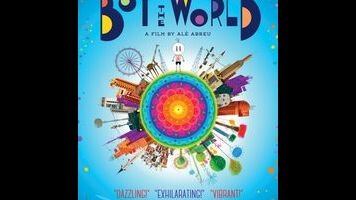The Boy And The World is part fantasy, part social realism. It’s both joyous and angry—an explosion of abstract colors that resolves into a vision of stooped human figures struggling to survive. Once The Boy leaves the country, he encounters both parades and sweatshops, and mountaintop metropolises that look magnificent from below but cramped and cruddy up close. The arc here is simple, and easy to follow: The tiny hero is driven out of paradise, and on his travels he gets a closer look at how things actually are. He sees rich kids floating above him in glittering cities, and arenas full of sports fans cheering pogo-booted athletes, while people in nearby slums subsist on canned glop (when they can afford it). But he also sees the working classes helping each other, when no one else will.
Although Abreu is Brazilian, and though the hilly slums in The Boy And The World resemble Rio’s favelas, the movie is set in an unspecified country, in some not-too-distant future. When the characters speak—which is rarely—they use an incomprehensible babble of nonsense syllables, and any street signs or billboards that The Boy encounters are rendered as a jagged collage of cut-up numbers, letters, and faces from magazines. The vagueness can be frustrating at times, especially since the story here is slight and episodic, and doesn’t reveal much about economic injustice that informed audiences shouldn’t already know.
But it’s the way Abreu tells it that matters. Building off the recurring visual motif of a kaleidoscope, The Boy And The World frequently shifts to overhead shots that reduce people and objects to geometric shapes, dancing around each other in eye-catching patterns. Meanwhile, Ruben Feffer and Gustavo Kurlat’s percussive score enhances the sense of modern life as an unstoppable machine that moves humans through a mill. The elaborate designs and the catchy sound keep the film’s energy level high, even when it’s showing The Boy nearly being crushed by stacks of shipping containers, or when Abreu sets the frame afire as part of a transition from animation to documentary footage of deforestation.
Abreu’s trickiest maneuver is his periodic flashbacks to The Boy’s memories of when he still lived with his mother and father in the country. The jumps from the present to the past aren’t always immediately evident, which makes them a little jarring at first, although the move pays off in an epilogue where The Boy finally does return home, and finds that the reality doesn’t match his nostalgia. Earlier in the film, an interlude shows one of the hero’s guardians making money on the weekends by converting his bicycle into a musical instrument, and playing for tourists on the beach. That image—like the matter-of-fact homecoming scene at the end of The Boy And The World—is a poignant metaphor for how people adapt even to dire circumstances, by making use of what they have and resolvedly moving on. As with the movie as a whole, the message those scenes deliver is a heady mix of uplifting and devastating.


 Keep scrolling for more great stories from A.V. Club.
Keep scrolling for more great stories from A.V. Club.